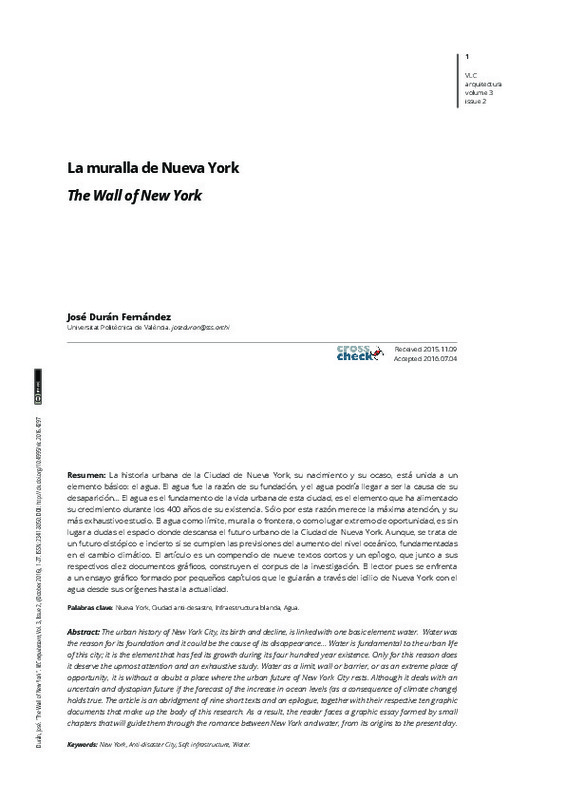JavaScript is disabled for your browser. Some features of this site may not work without it.
Buscar en RiuNet
Listar
Mi cuenta
Estadísticas
Ayuda RiuNet
Admin. UPV
The Wall of New York
Mostrar el registro sencillo del ítem
Ficheros en el ítem
| dc.contributor.author | Durán Fernández, José
|
es_ES |
| dc.coverage.spatial | east=-74.0059728; north=40.7127753; name= New York, NY 10007, Estats Units d'Amèrica | |
| dc.date.accessioned | 2016-11-03T09:10:10Z | |
| dc.date.available | 2016-11-03T09:10:10Z | |
| dc.date.issued | 2016-10-27 | |
| dc.identifier.issn | 2341-3050 | |
| dc.identifier.uri | http://hdl.handle.net/10251/73199 | |
| dc.description.abstract | [EN] The urban history of New York City, its birth and decline, is linked with one basic element: water. Water was the reason for its foundation and it could be the cause of its disappearance… Water is fundamental to the urban life of this city; it is the element that has fed its growth during its four hundred year existence. Only for this reason does it deserve the upmost attention and an exhaustive study. Water as a limit, wall or barrier, or as an extreme place of opportunity, it is without a doubt a place where the urban future of New York City rests. Although it deals with an uncertain and dystopian future if the forecast of the increase in ocean levels (as a consequence of climate change) holds true. The article is an abridgment of nine short texts and an epilogue, together with their respective ten graphic documents that make up the body of this research. As a result, the reader faces a graphic essay formed by small chapters that will guide them through the romance between New York and water, from its origins to the present day. | es_ES |
| dc.description.abstract | [ES] La historia urbana de la Ciudad de Nueva York, su nacimiento y su ocaso, está unida a un elemento básico: el agua. El agua fue la razón de su fundación, y el agua podría llegar a ser la causa de su desaparición... El agua es el fundamento de la vida urbana de esta ciudad, es el elemento que ha alimentado su crecimiento durante los 400 años de su existencia. Sólo por esta razón merece la máxima atención, y su más exhaustivo estudio. El agua como límite, muralla o frontera, o como lugar extremo de oportunidad, es sin lugar a dudas el espacio donde descansa el futuro urbano de la Ciudad de Nueva York. Aunque, se trata de un futuro distópico e incierto si se cumplen las previsiones del aumento del nivel oceánico, fundamentadas en el cambio climático. El artículo es un compendio de nueve textos cortos y un epílogo, que junto a sus respectivos diez documentos gráficos, construyen el corpus de la investigación. El lector pues se enfrenta a un ensayo gráfico formado por pequeños capítulos que le guiarán a través del idilio de Nueva York con el agua desde sus orígenes hasta la actualidad. | es_ES |
| dc.language | Español | es_ES |
| dc.language | Inglés | es_ES |
| dc.publisher | Universitat Politècnica de València | |
| dc.relation.ispartof | VLC arquitectura. Research Journal | |
| dc.rights | Reconocimiento - No comercial (by-nc) | es_ES |
| dc.subject | New York | es_ES |
| dc.subject | Water | es_ES |
| dc.subject | Soft infrastructure | es_ES |
| dc.subject | Anti-disaster City | es_ES |
| dc.subject | Nueva York | es_ES |
| dc.subject | Ciudad anti-desastre | es_ES |
| dc.subject | Infraestructura blanda | es_ES |
| dc.subject | Agua | es_ES |
| dc.title | The Wall of New York | es_ES |
| dc.title.alternative | La muralla de Nueva York | es_ES |
| dc.type | Artículo | es_ES |
| dc.date.updated | 2016-10-31T13:36:01Z | |
| dc.identifier.doi | 10.4995/vlc.2016.4297 | |
| dc.rights.accessRights | Abierto | es_ES |
| dc.contributor.affiliation | Universitat Politècnica de València. Departamento de Proyectos Arquitectónicos - Departament de Projectes Arquitectònics | es_ES |
| dc.contributor.affiliation | Universitat Politècnica de València. Escuela Técnica Superior de Arquitectura - Escola Tècnica Superior d'Arquitectura | es_ES |
| dc.description.bibliographicCitation | Durán Fernández, J. (2016). The Wall of New York. VLC arquitectura. Research Journal. 3(2):1-27. https://doi.org/10.4995/vlc.2016.4297 | es_ES |
| dc.description.accrualMethod | SWORD | es_ES |
| dc.relation.publisherversion | https://doi.org/10.4995/vlc.2016.4297 | es_ES |
| dc.description.upvformatpinicio | 1 | es_ES |
| dc.description.upvformatpfin | 27 | es_ES |
| dc.type.version | info:eu-repo/semantics/publishedVersion | es_ES |
| dc.description.volume | 3 | |
| dc.description.issue | 2 | |
| dc.identifier.eissn | 2341-2747 | |
| dc.description.references | Rohe, Mies Van Der. "Conversando con Mies." Entrevistado por Baeza, Antonio y Jaime Marquez. Colección Fundadores. Archivo Histórico José Vial Armstrong, Pontificia Universidad Católica de Valparaíso, 1959. | es_ES |
| dc.description.references | Bone, Kevin. The New York waterfront: Evolution and building culture of the port and harbor. NewYork: The Monacelli Press, 2004. | es_ES |
| dc.description.references | Borges, Jorge Luis. El Aleph. "Historia del guerrero y la cautiva." Madrid: Alianza Editorial, 1997. | es_ES |
| dc.description.references | Caro, Robert. The Power Broker: Robert Moses and the Fall of New York. New York: Vintage Books, 1975. | es_ES |
| dc.description.references | Ferriss, Hugh. The Metropolis of Tomorrow. New York: Princeton Architectural Press, 1986. Originally published in 1929. | es_ES |
| dc.description.references | Frampton, Kenneth. Nueva York Capital del siglo XX. Una guía histórica de la arquitectura de Manhattan. Madrid: Abada Editores, 2004. | es_ES |
| dc.description.references | Mcelroy, Samuel. "Lines of movement." In: Town survey commission of Kings County: Report of Samuel McElroy, superintendent of survey. New York: Rome Brothers printers, 1874. | es_ES |








